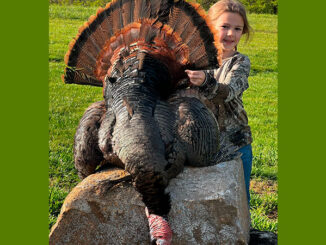
Opening of trout season brings back memories
I’m old enough to remember when the trout season on hatchery-supported streams closed in the fall and remained closed until the first Saturday in April. That was before I began fishing wild trout streams, so opening day was a special event. A group of us, mostly newspaper types, would open the fishing season on Santeetlah Creek in Graham County, staying in a 100-year-old, mice-infested cabin on upper Santeetlah. We would arrive late Friday afternoon and spend the evening drinking vintage bourbon, playing nickel-dime poker and telling fish stories.
Al Geremonte, the newspaper’s outdoor writer, was cook and chief raconteur, and when he was sufficiently plied with bourbon, he would tell his big-fish story.
“I was fishing from the bank in the lower section of the Oconaluftee River and wasn’t getting any strikes, so I started reeling in line so I could change flies,” Geremonte told the story. “Just when my fly got to the edge of the stream, this big brown trout darted out and followed that fly right up on the bank. He was completely out of the water when he snatched the fly. I was so surprised, I just stood there. He dove back into that pond, snapping my line like it was made of thread. It must have weighed 10 or 12 pounds.”
No one ever attempted to top that story. When I first heard it, the trout was a 5-pound rainbow, not a brown. It grew with each telling.
We would get up early, eat ham biscuits that Al fixed, and head for the stream. When we caught our limit, we quit, returned to the cabin and took a nap.
For dinner that evening, we had trout fried to perfection in a big, cast-iron frying pan, fried potatoes seasoned with fresh ramps that Al always was able to find, and a big slab of home-made cornbread.
The opening-day ritual continued for several years. until there were too few of us left to make the trip worthwhile or interesting.
Although I seldom go on opening day now because I’ve become less tolerant of crowds, but I always remember those times with great fondness.
The 2015 trout season opens at 7 a.m. Saturday, April 4, on state-managed, hatchery-supported waters. Streams have been generously stocked for opening day, and the trout have had adequate time to spread out and become acclimated to their new surroundings.
If you get to a stream early enough, you’re almost guaranteed a mess of fish for supper.
The N.C. Wildlife Resources Commission plans to stock approximately 900,000 trout for the 2015-2016 season. A large portion of those will go into delayed-harvest waters, but hatchery-supported waters will get a fair share.
The majority of the stockers, 96 percent, will be rainbow and brook trout running at least 10 inches, and the other 4 percent will be brown trout running 14 inches and longer. Bigger streams, of course, get the most fish for the April opening: 3,500 for the Tuckasegee River in Jackson County, 3,500 for Jonathan Creek in Haywood County, 3,500 for the North Toe in Avery County, 2,500 for the South Toe in Yancey County, 2,250 for Big Snowbird in Graham County and 2,000 for the lower Linville River in Burke County. Cliffside Lake in Macon County gets 2,000 brook and rainbow for opening day.
Other stocked lakes in addition to Cliffside are Powhatan in Buncombe County, Cheoah Reservoir in Graham County, Balsam Lake, Bear Creek Lake, and Tanasee Creek Lake in Jackson County, Queens Creek Lake in Macon County, Max Patch Pond in Madison County, and Calderwood Reservoir in Swain County.
The state’s hatchery-supported fishing program has approximately 1,000 miles of streams and several small lakes. Trout for District 9, which covers the 12 westernmost counties, are produced at the Pisgah State Fish Hatchery near Brevard. Trout for District 7 and 8 are produced at the Armstrong Hatchery in McDowell County.
Hatchery-supported trout waters are posted with green and white signs along the waterway.
The daily creel limit in hatchery-supported waters is seven trout. There is no size limit, and fishers may use either lures, artificial bait, or live bait.
Most state-managed streams are stocked once a month through August. Some of the more heavily fished streams are stocked more often. These streams include the lower section of the Davidson River in Transylvania County, the Rocky Broad River in Rutherford County, Jonathan Creek in Haywood County, the Swannanoa River and Lake Powhatan in Buncombe County, and the South Toe and Cane rivers in Yancey County. Streams are stocked more heavily during the cooler months, usually March through June. Fewer fish are put in streams during hot weather months, July through August, because water temperatures frequently are too high for trout to survive.
Hatchery fish can be caught on a variety of baits and lures. Berkley Power Baits and commercial salmon eggs have become very popular with fishers, and they catch as many fish as crickets and nightcrawlers. Best Power Bait colors for early season and clear water are chartreuse and yellow. If the water is dingy, use fluorescent orange, red or pink.
Fishing hatchery-supported streams is guilt-free fishing. The fish you catch for your dinner are there for just that purpose.





Be the first to comment